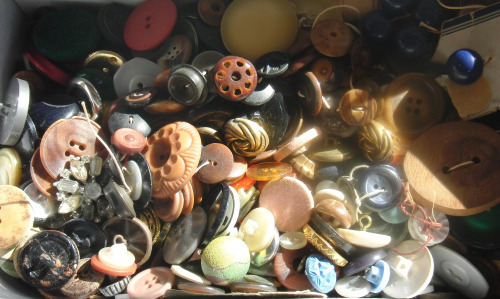Charm Strings
When poet Amy Ludwig Van Derwater announced she was putting together a string of buttons Victorian ladies called a charm string, and requested a button from friends, I spilled out my button box. Memories rose from the soft clatter. One green cloth button was from a vintage coat I bought during the first winter my husband and I spent together. A wee frog was from when my grown daughter was a baby. Bent and broken paper cards of buttons had been retrieved from my mother’s jar of buttons after she died. And I found a few wooden buttons I’d bought after the owner of a used bookshop gave me a copy of Maine Charm Strings, decades ago, saying she thought the book was meant for me.
Recently I spoke with a friend about journals we had as girls, and how often first diaries are gifts from older women: that precious belief that we had something to say, before we knew that ourselves. I also love the idea of buttons moving from hand to hand, with their various colors, shapes, and the vaguest hints of stories, which change in every pair of ears, eyes, and hands. You can read more about Amy’s quest for buttons and words at The Poem Farm. And please comment there before next Thursday for a chance to win a copy of my book, Views from a Window Seat.
The gift of one book inspired one of my own, set in nineteenth century Salem. It was never published, but below is an excerpt in which Lucy’s older sister introduces her to charm strings:
“You’re just the right age to start a charm string.” Caroline lowered her voice the way she did whenever she spoke of magic. She unrolled some string saved from packages. Using tiny bird-shaped scissors, she snipped off a piece of string as long as Lucy’s arm.
“All you have to do is thread the buttons together. Every button should be different. Start with a large one. That round wooden one looks good. You put them on the string until you have nine hundred and ninety-nine.”
“What happens then?”
“Your life changes. You win the great dream of your heart.”
Lucy laced the string through two holes in the polished wooden button, then threaded on a brass, china, and cloth-covered button. She looked through the buttons darkened by time and chose one that was fan-shaped, one with a picture of a solemn, still robin, a speckled stone button and one made from a ribbon coiled into a rose. The rest were plain and round, but smooth as the wave-worn rocks on the beach. They felt good on her palm.
Caroline picked up another one that showed a cat with tiny painted whiskers, a little dot of a mouth, dark ears, and a curled-in tail. “Don’t take so many that the pile looks smaller when you’re done. Twelve buttons is good to start. After this you either have to find the buttons or they should be gifts. The more buttons you get, the luckier you’ll be.”
Lucy slipped a silver button on the string. The sound was soothing, like milk splashing from a pitcher. “If you don’t have all the buttons you need, how do you know that it works? Mother says you shouldn’t believe everything you’re told.”
“Sometimes you have to be content with hints instead of proof. You don’t expect the seashells and stones you find washed up on the shore to tell you everything about the ocean. You can’t expect clouds to spell out the afternoon’s weather.”
“That’s different.”
“Mother’s right that you shouldn’t believe everything you hear, but if lore has been passed along, it’s lasted for a reason.”
For more Poetry Friday posts, please visit Tara at A Teaching Life.






